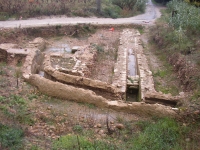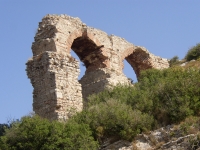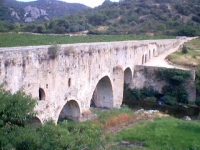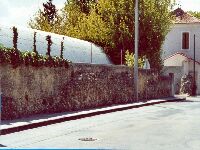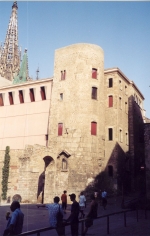| This intriguing basin is almost the last visible remain of an aqueduct in Bellegarde (France). The left outlet was probable connected to a ornamental fountain; the right one heads towards Arles, but only some pillar foundations are known. |
Apart from its famous Eupalinos aqueduct (6th c bc), Samos was also embellished by a Roman aqueduct including this bridge. No source nor destination is known from this aqueduct. |
In the south of France, near Ansignan, one can find an aqueduct bridge crossing a valley of which nothing is known: source, destination nor construction date. Is it Roman, see the poem of Allister Elliot |
The French town of Orange is known because of its theater and Roman land registry map. Less known is its aqueduct of which only the substruction along the town wall is known. Source and destination are unknown. |
Barcelona (Spain) was also equipped with at least one Roman aqueduct of which here one arch is represented. In recent years, in the area of the train station, more remains are found. Research goes on. |
Rome's unknown aqueducts
The Curiosum, Notitia and Silvius all list a number of aqueducts that are either unknown or not known for certain. See the table for a complete list of known aqueducts in
Rome. The aqueducts in doubt are: Annia, Atica, Attica, Anena, Herculea, Heracliana, Caerulea, Augustea, Ciminia, Aurelia, Damnata, Severiana, Antoniniani
and Dorraciana. These may be aqueducts that are unknown to us today, but it is far more likely that they are misnamed or renamed known aqueducts or branches of known
aqueducts. The following section will discuss each of the above, as well as some other possibilities from other sources.To this list can be added the Annesis.
Annia
As both the Anio Vetus and Novus are not mentioned in the list, it is likely that this is corruption for one or both of them. The fact that there is no other listing of an Annia adds
weight to this hypothesis (Platner & Ashby, 1965:21). Richardson (1992:15) agrees with this interpretation. The Annia may very well be Polemius Silvius' (545) 'Anena'.
The similarity of 'Annia' to 'Anio' adds weight to this belief.
Atica and Attica
According to Platner & Ashby (1965:21), this is also likely to be a corruption of Anio Vetus or Novus. This requires a greater stretch of the imagination. Richardson (1992:16)
states that Atica or Attica is probably a corruption of the word "Antiqua". This might then refer to an older aqueduct.
Antoniniani
This may refer to the fons Antoninianus, which was added to the Marcia's supply by Caracalla, according to Platner & Ashby (1965:25). According to Richardson (1992:18),
this probably occurred outside the city , perhaps at the third milestone of the Via Latina. This new branch, the Antoniniani, would have supplied the Baths of
Caracalla. So great was the water supply to the Baths of Caracalla that a water-mill was installed in the basement (Hodge, 2002:270).
Augustea or Augusta
Platner & Ashby (1965:22) state that this may refer to the Aqua Alsietina, or possibly (at a stretch) the fons Augustae of the Aqua Marcia. Richardson (1992:16) states
that it is an alternative name for the Alsietina, and also the name of a supplement of the Appia that joined it at Gemellos. This is in agreement with Frontinus (1.1),
who states clearly: 'Alsietina, which is also called Augusta'. However, Frontinus also states of the Appia (1.5): 'Near Spes Vetus... there joins it a branch of Augusta,
added by Augustus, as a supplementary supply. Ashby (1935:50) concurs with this.
Frontinus mentions two other possibilities for Augustea or Augusta. The first (1.11), is the Alsietina, which is no doubt where Richardson drew his conclusion from.
In I.12 Frontinus states that Augustus added a feeder to the Marcia, which was called Augusta after its donor. Occasionally, when the Marcia could not carry the
volume of water from the Augusta, it would be diverted to the Claudia.
It is not clear which of these is the one referred to by the Curiosum, Notitia and Silvius. The Augusta mentioned in 1.12 seems to be a minor branch; but one is tempted
to to come to the conclusion that it is the aqueduct in question, especially considering it fed two aqueducts. However, a larger aqueduct is more probable.
Aurelia
Platner & Ashby (1965:22) offer no explanation for this aqueduct, but, like the Ciminia, believe that it might actually refer to a road. Richardson (1992:16) is of the opinion
that it might refer to a spring near the summit of the Janiculum north of the Via Aurelia. However, he goes on to make an excellent point. He states that as all the identifiable
items in the Curiosum, Notitia and Silvius Polemius, it is more likely that the Aurelia is an alternate name for one of the more familiar aqueducts. This logic applies equally to
the other unidentified items in the lists.
Caerulea
Platner & Ashby (1965:22) identify this with the Aqua Claudia. This possibly after the fact that one of the springs that fed the Claudia was the Caeruleus. It is also possible
that Caerulea is an alternate name for the Claudia, or perhaps a part of it, after the Neronian Arcus Caelimontani, but this is admittedly a stretch.
Cernens
The 'Cernens' is only mentioned in the Notitia. Platner & Ashby (1965:22) offer no explanation. Richardson (1992:16) speculates that it might refer to a fountain
on Vicus Tuscus or the lower slopes of the Palatine, and not an actual aqueduct. Translating the name 'Cernens' provides a tempting clue, a suggestion that it might
be a branch and not a separate aqueduct.
Ciminia
Platner & Ashby (1965:22) offer no explanation for this aqueduct, but believe that it might actually refer to a road. Richardson (1992:16) believes identification to be unlikely.
Conclusa
The Conlcusa is mentioned only in one inscription, recorded in CIL as 6.33087 (see Chapter \ref{cil633087}). It places the aqueduct on the Esquiline, but is probably
the name of one of another aqueduct's tanks (Platner & Ashby, 1965:23). Richardson (1992:17) speculates that it might refer to a covered 'piscina' or
the 'castellum' of the Claudia and Anio Novus. The word 'Conclusa' certainly seems to indicate this.
Damnata
Platner & Ashby (1965:23) offer only speculation about this aqueduct. They speculate it may be the same as Polemius Silvius' (545) Aqua Dotraciana or Dorraciana.
Jordan (1907) suggests it might be a corruption of Diocletiana. While this may be true, it does little to clear the matter up. Richardson (1992:17) believes it may be a
nickname for the Alsietina. Fabretti (Evans, 2002:186) states that the Damnata is the name that was given to the Crabra after its waters become too foul for drinking
purposes. Originally, Agrippa had not used this water to supply the Julia, but later corrupt water-men had. Frontinus restored the Crabra "at the emperor's command"
and restored its waters to the Tusculan proprietors. Frontinus (1.9) is quite clear that the Crabra is a brook; Frabretti's reasoning is unclear on this matter and we defer
to Frontinus.
Dorraciana
It has been speculated that this is the Damnata by Platner & Ashby (1965:23). However, there is little solid evidence for this speculation. There is even less evidence
to lead to any substantial speculation as to the actual nature of the Dorraciana.
Drusia
The Drusia is mentioned only by Polemius Silvius(546). Richardson (1992:17) speculates that it may be the Anio Vetus, which may have passed over the Arcus Drusi.
Herculea or Heracliana
According to Platner & Ashby (1965:23), this is not an aqueduct, but rather the 'rivus Herculaneus' of the Aqua Marcia. The Anio Novus also has a branch with
the same name (Frontinus, 1.15),\footnote{Frontinus calls it a brook.} and Pliny (31.31) connects the rivus with the Aqua Virgo. For both these latter cases
Platner & Ashby are difficult to reconcile with the evidence.
Mercurii
Ovid ('Fasti', 5.673) is the only one to mention this aqueduct and he only mentions it once. He places it near the Porta Capena. The only mention is:
est aqua Mercurii portae vicina Capenae;
si iuvat expertis credere, numen habet.
huc venit incinctus tunica mercator et urna
purus suffita, quam ferat, haurit aquam.
Richardson (1992:18) states that it is unlikely that there was ever a separate spring dedicated to Mercury, so it is unlikely to have been an aqueduct. The Mercurii is probably
an invention of Ovid for fictional purposes.
Pinciana
The Pinciana is known only from a single inscription on a waterpipe (CIL 15.7259) near the porta Salaria (See chapter 3.5). Platner & Ashby (1965:27)
speculate that it might have carried water to the Domus Pinciana. Thus it was perhaps not an aqueduct but merely a pipe. Richardson (1992:18) is puzzled, because it is
logical to expect that the Domus Pinciani would be supplied by the Virgo, but the location of this pipe would make it unlikely. Perhaps then the Pinciani was a supplement,
built for reasons now unknown.
Severiana
The Severiana is mentioned only in the 'Not. app'. and Polemius Silvius. Platner & Ashby (1965:27) offer no further ideas as to the nature of this aqueduct. Nor
does Richardson (1992:18).
The 'aqua' that never was: AQUANEVER
According to Livy (40.51.1), in 179 BC censors M. Fulvius Nobilior and M. Aemilius Lepidus enjoyed the allocation of an entire years 'vectigal' (tax revenue).
This money was to be used for public building contracts. This included aqueduct repair and the creation of a new aqueduct. The construction of the new aqueduct was
blocked by M. Licinius Crassus, who would not give right of way for the construction over his land (Anderson, 1997:83). Numismatic evidence sheds some light on the matter.
However, some believe that the aqueduct may actually have been built, at least partially, and that the Marcia was built from this pre-existing but incomplete aqueduct.
As the Marcia was the longest of the aqueducts by a fair margin, there may be some truth to this belief. However, the evidence is lacking, and most scholars, notably
M.G. Morgan reject the notion that construction began on this earlier aqueduct.
|
